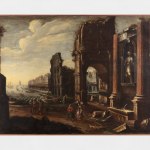-
Biography
Viviano Codazzi (Bergamo, Italy, c. 1603 – Rome, Italy, 1670)
Born in Bergamo in 1603 to his father Maffeo, who was also an artist, Viviano Codazzi left his native city around 1620, first moving to Rome and then to Naples.
He remained in Rome until 1634, becoming one of the first painters to engage with Vedutism in an urban context, with a strong influence from Caravaggio.
In 1634, he moved to Naples, where he collaborated with Domenico Gargiulo and many of his contemporaries, especially on architectural backgrounds. Here, he became involved in the local literary scene, participating in the “honoured symposia” at Angelo Pepe’s house, alongside fellow artists and writers.
The artworks he painted in these years became a crossroads of various styles: the strong rigour of Renaissance perspective, the pre-Romantic influence reflected in an interest in ruins, and the realistic approach of Vedutism. The combination of these themes gave shape to a new pictorial vision, where architectural views and ruins were rendered with geometric precision, enriched by shadows and plays of light.
His painting activity was disrupted by the uprisings in Naples in 1647.
Having fallen into poverty due to missed payments, he returned to Rome in 1648. Some of his most famous works belong to this period, including Veduta di Piazza del Popolo (Whim view of the Piazza del Popolo, 1660) or Rovine del Museo di Arezzo (Ruins of Arezzo’s museum, 1663). During this time, he cooperated with numerous artists, including Cerquozzi, Jan Miel, and Pallavicini.
The style of this Roman phase differs significantly from that of the Neapolitan period, being much more rigid and formal.
He died in Rome in 1670.
Photo UniCredit Group (Sebastiano Pellion di Persano)
-
Works
Viviano Codazzi (Attribuito a) Italian, 1603-1670
Porto con figure, 1630Oil on canvas / Olio su tela / Öl auf Leinwand59 x 82 1/2 in
150 x 209.5 cmUniCredit S.p,A.Photo: UniCredit Group (Sebastiano Pellion di Persano)1of 2
Join our mailing list
* denotes required fields
In order to respond to your enquiry, we will process the personal data you have supplied in accordance with our privacy policy.






